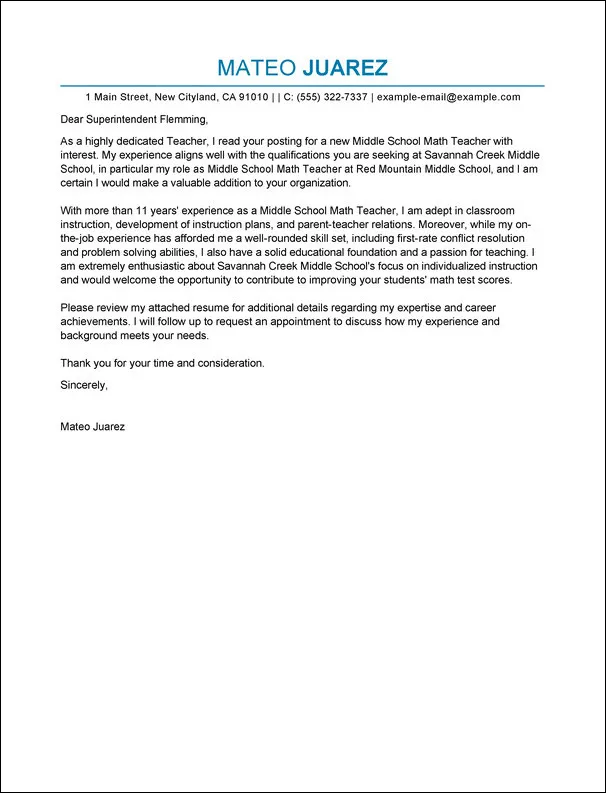Crafting a Compelling Teacher Cover Letter
A well-crafted cover letter is your first opportunity to make a strong impression on a potential employer. For teachers, this document serves as a crucial introduction, allowing you to showcase your passion for education, highlight your relevant experience, and demonstrate why you are the ideal candidate for the position. A compelling cover letter should not merely reiterate your resume; instead, it should provide a narrative, offering insights into your teaching philosophy, your accomplishments, and your unique qualifications. It’s a chance to go beyond the list of skills and experience and connect with the hiring committee on a personal level, expressing your enthusiasm for the role and the school’s mission. Remember, the goal is to make the reader want to learn more about you and invite you for an interview. (Image: teacher-cover-letter-sample.webp)
Understanding the Purpose of a Teacher Cover Letter
The primary purpose of a teacher cover letter is to persuade the reader that you possess the necessary skills, experience, and personal qualities to excel in the teaching position. It is not simply a summary of your resume but an opportunity to provide context and demonstrate how your background aligns with the specific requirements of the job and the values of the school. It allows you to articulate your teaching philosophy, describe your approach to classroom management, and provide examples of your successes. A well-written cover letter also helps you to differentiate yourself from other applicants by showcasing your unique strengths and the contributions you can make to the school community. It is a reflection of your professionalism, communication skills, and attention to detail, all of which are essential qualities for a successful educator. (Image: teacher-applying.webp)
Highlighting Your Qualifications Effectively
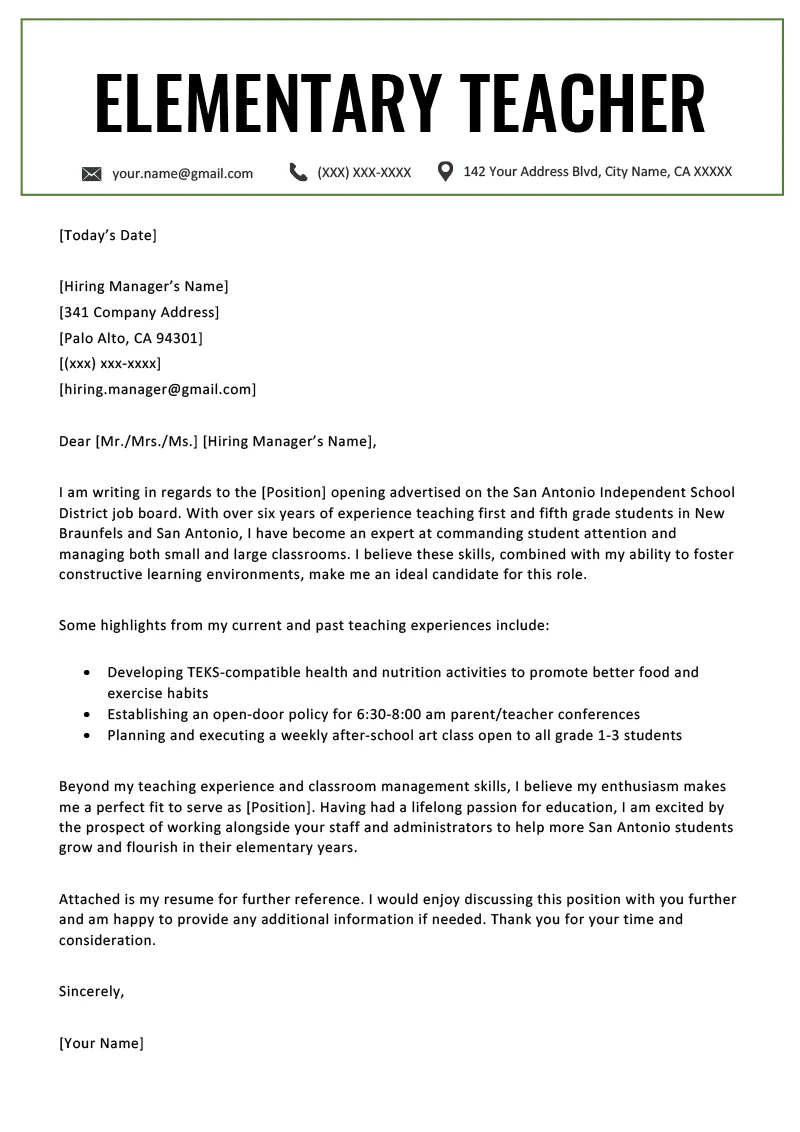
When highlighting your qualifications, focus on the skills and experiences that are most relevant to the specific teaching position. Carefully review the job description and identify the key requirements and desired attributes. Then, in your cover letter, provide specific examples of how you have demonstrated those skills in previous roles or during your teacher training. Instead of just listing your qualifications, offer concrete examples of your accomplishments. For instance, if the job description emphasizes classroom management, you could describe a time when you successfully implemented a new strategy to improve student behavior. Always aim to connect your qualifications with the needs of the school, showing the hiring committee how you can contribute to their students’ success. Remember to use keywords from the job description to show the hiring committee that you read the job post thoroughly and are capable to do the job. (Image: teaching-experience.webp)
Showcasing Relevant Teaching Experience
Your cover letter is an excellent place to showcase your teaching experience, even if it is limited. Focus on the types of schools you have taught in, the subjects and grade levels you have covered, and your specific roles and responsibilities. If you are an early-career teacher, highlight your student teaching experiences, including the subjects you taught, the curriculum you developed, and any innovative teaching methods you employed. For experienced teachers, provide examples of successful projects, curriculum enhancements, and any leadership roles you have held. Always emphasize the impact you had on student learning and achievement. Did you improve test scores? Did you implement a new program that increased student engagement? Quantify your accomplishments whenever possible to demonstrate your effectiveness. (Image: teaching-experience.webp)
5 Tips to Impress with Your Teacher Cover Letter
Tailor Your Letter to Each School
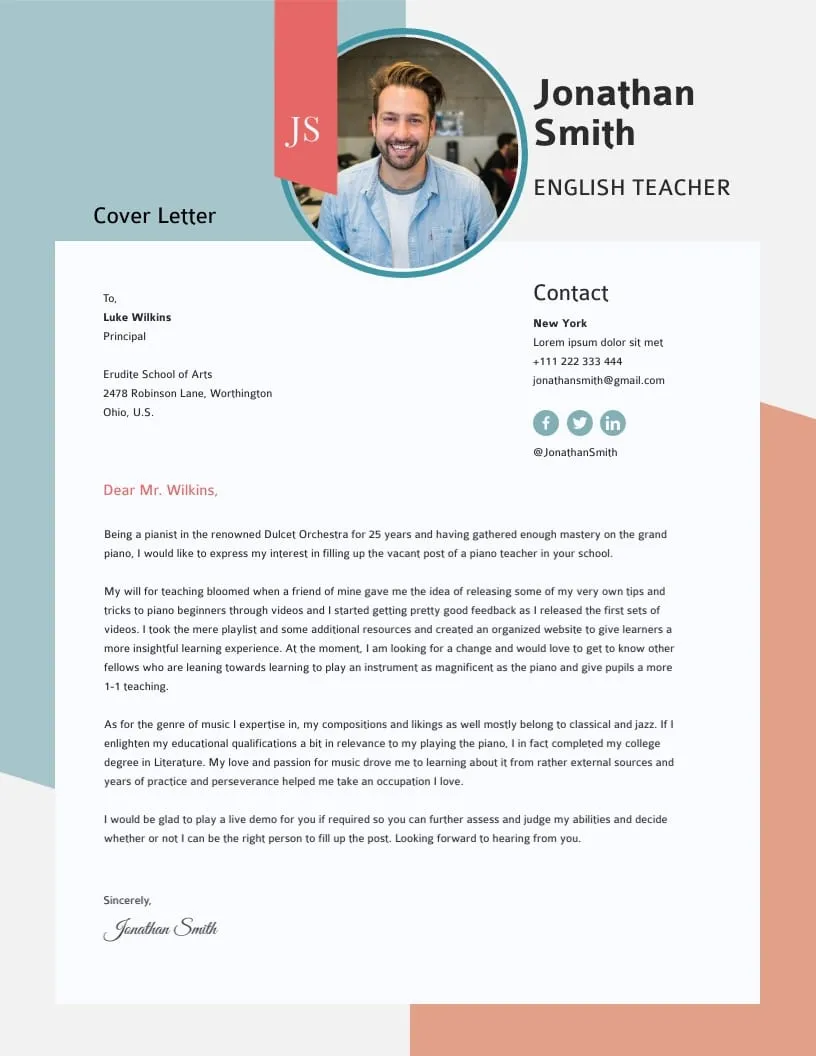
One of the most important tips for writing a compelling cover letter is to tailor it to each school you apply to. Generic cover letters are easily identified and often dismissed. Research the school’s mission, values, and programs and demonstrate how your skills and experience align with their specific needs. Mention specific programs, initiatives, or philosophies that resonate with you. Show that you have taken the time to understand the school and that you are genuinely interested in joining their community. This level of personalization demonstrates your enthusiasm and commitment, significantly increasing your chances of getting noticed. You can also demonstrate your passion by including some information about your teaching style.
Emphasize Your Achievements
Focus on your accomplishments, not just your responsibilities. Instead of stating that you taught a certain subject, describe how you improved student test scores or implemented a new curriculum that led to increased engagement. Use specific examples and data to illustrate your successes. This could include student improvement, praise you have received from parents or superiors, or any other accomplishments that showcase your capabilities as an educator. This will help potential employers understand the value you will add to their school. Highlight projects that you led that show your ability to guide or teach others. (Image: teacher-achievements.webp)
Use Action Verbs
Use strong action verbs to describe your accomplishments and responsibilities. Instead of saying you “were responsible for” a certain task, use verbs like “developed,” “implemented,” “managed,” “led,” “created,” or “achieved.” These verbs create a sense of energy and demonstrate that you are a proactive and results-oriented educator. Action verbs paint a vivid picture of your contributions and help to make your cover letter more engaging and memorable. Ensure that your verbs are varied and accurately reflect your role and the impact you had in previous positions. Remember the importance of making sure the grammar you use is accurate, to give an impression of intelligence and meticulousness.
Quantify Your Accomplishments
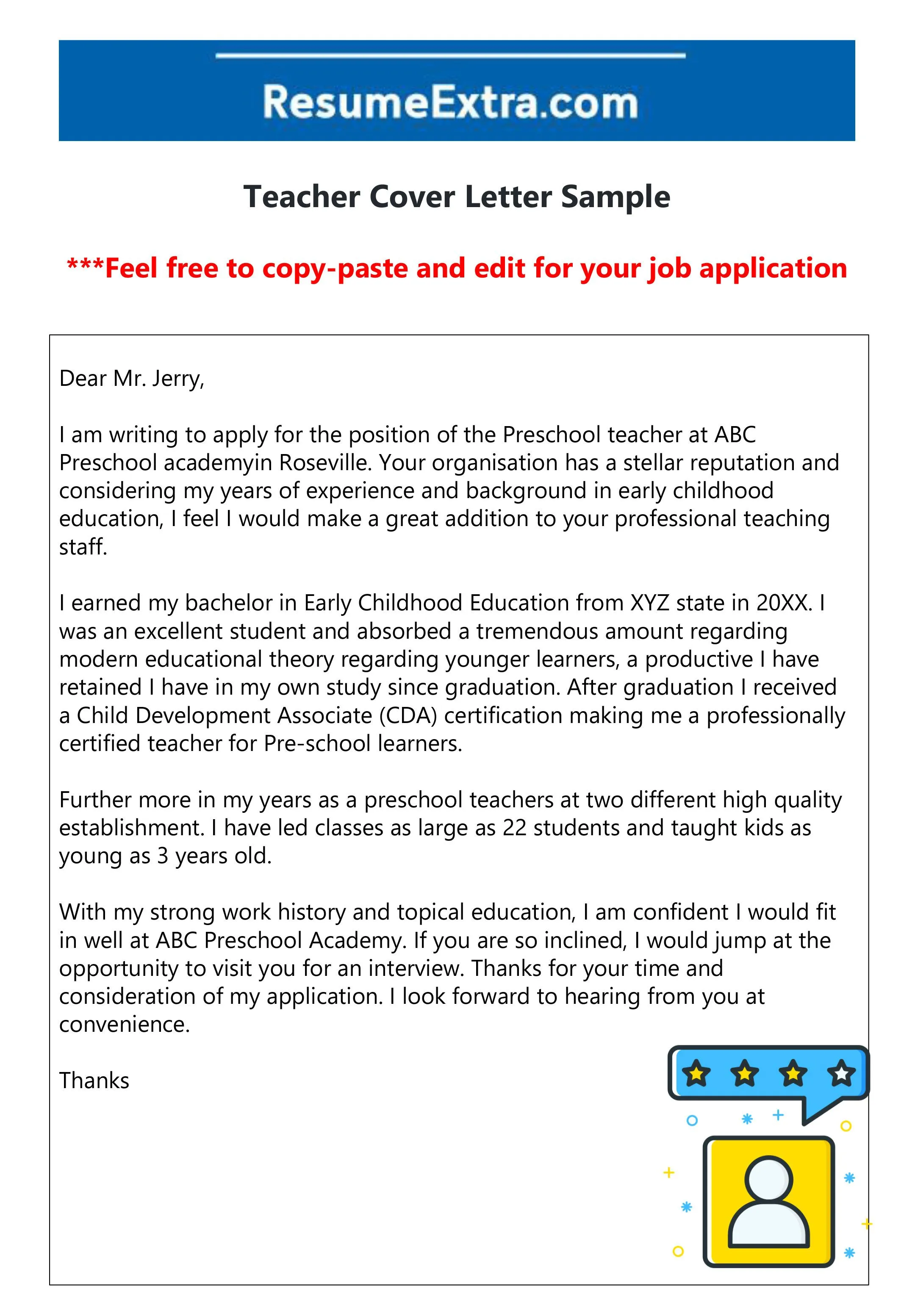
Whenever possible, quantify your achievements to make them more impactful. Instead of saying that you improved student performance, state that you “increased student test scores by 15%.” Instead of saying that you “improved classroom management,” describe how you “reduced disciplinary incidents by 20%.” Numbers and data provide concrete evidence of your effectiveness and demonstrate that you are results-driven. Quantifying your accomplishments not only makes them more impressive but also helps the hiring committee understand the tangible impact you have had in previous roles. This will show your potential employer that you are capable of leading a classroom.
Proofread Meticulously
Before submitting your cover letter, proofread it meticulously for any errors in grammar, spelling, or punctuation. Mistakes can create a negative impression and suggest a lack of attention to detail, which is a crucial skill for a teacher. Read your cover letter multiple times, and consider asking a friend, colleague, or career advisor to review it as well. Use spell check and grammar check tools, but don’t rely on them entirely. A fresh pair of eyes can often catch errors that you may have missed. Ensure that your cover letter is polished and professional, reflecting your commitment to excellence. (Image: proofread-cover-letter.webp)
Formatting for Maximum Impact
Choosing the Right Font and Size
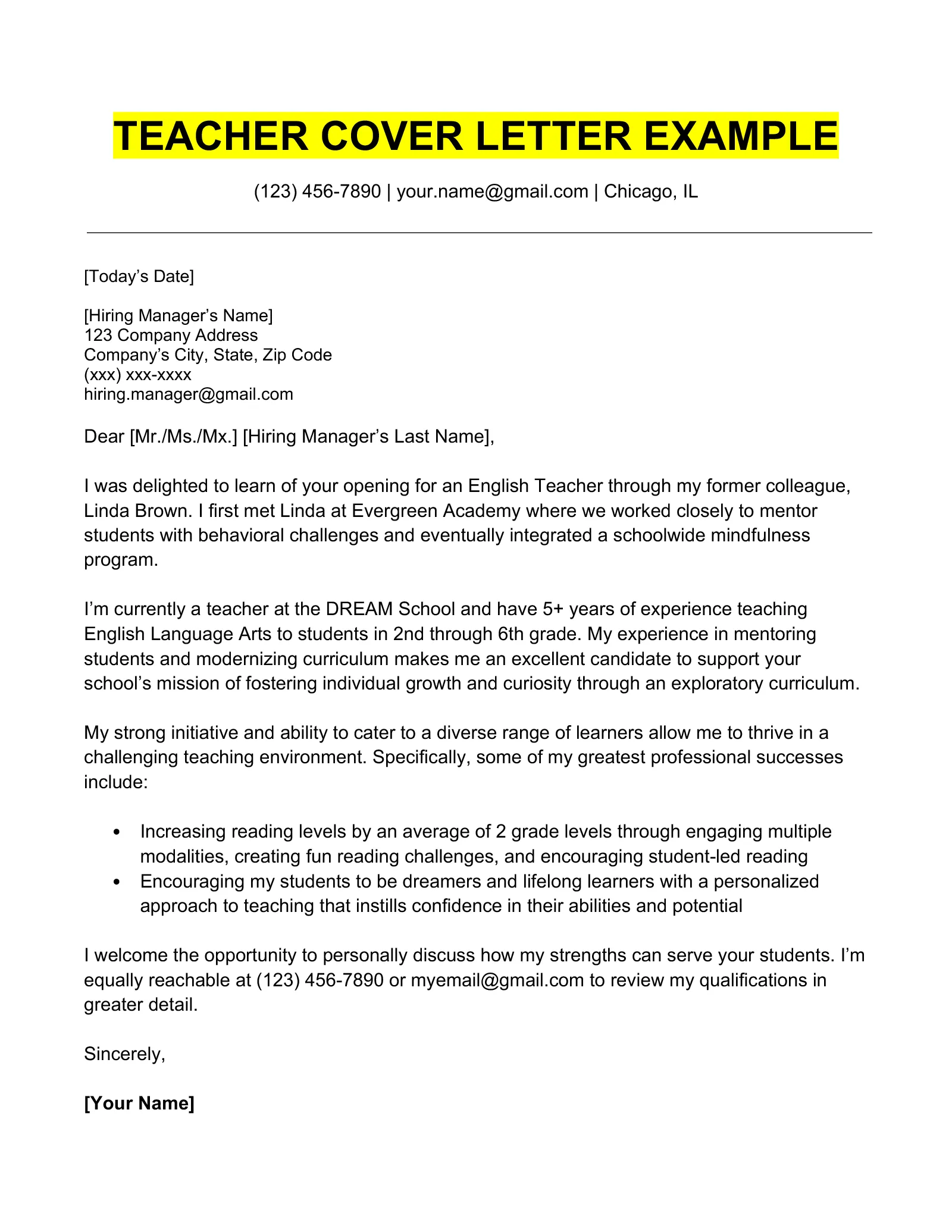
Choose a professional and easy-to-read font, such as Times New Roman, Arial, or Calibri, and use a font size between 11 and 12 points. Ensure that the font size is readable without being too large or too small. A clean and uncluttered font will enhance readability and make your cover letter more approachable. Avoid using overly decorative or unusual fonts, as they can distract the reader and detract from your message. Consistent formatting throughout your letter is also important. Also, be mindful of the potential for the cover letter to be read on a variety of devices and ensure the font is clear and readable.
Structuring Your Letter Logically
Structure your cover letter logically, with a clear introduction, body paragraphs, and conclusion. Start with a compelling opening that grabs the reader’s attention. In the body paragraphs, discuss your relevant experience, qualifications, and achievements, using specific examples to support your claims. Organize your information in a way that is easy to follow, with each paragraph focusing on a specific aspect of your qualifications. Use headings and subheadings to break up the text and make it more visually appealing. Ensure that your ideas flow naturally and that the letter has a clear and concise message. This shows the potential employer your ability to organize and articulate thoughts in a logical manner.
Contact Information and Salutations
Include your contact information at the top of the cover letter, including your name, address, phone number, and email address. Make sure that your email address is professional. Use a formal salutation, such as “Dear Mr./Ms./Mx. [Last Name]” if you know the hiring manager’s name. If you are unsure, use “Dear Hiring Committee” or “Dear [School Name] Principal.” In the closing, use a professional closing, such as “Sincerely” or “Best regards.” Ensure your contact information is accurate and up to date to make it easy for the hiring committee to reach you. Ensure the salutation is addressed to the right person as it makes the letter more personal.
Closing Your Cover Letter
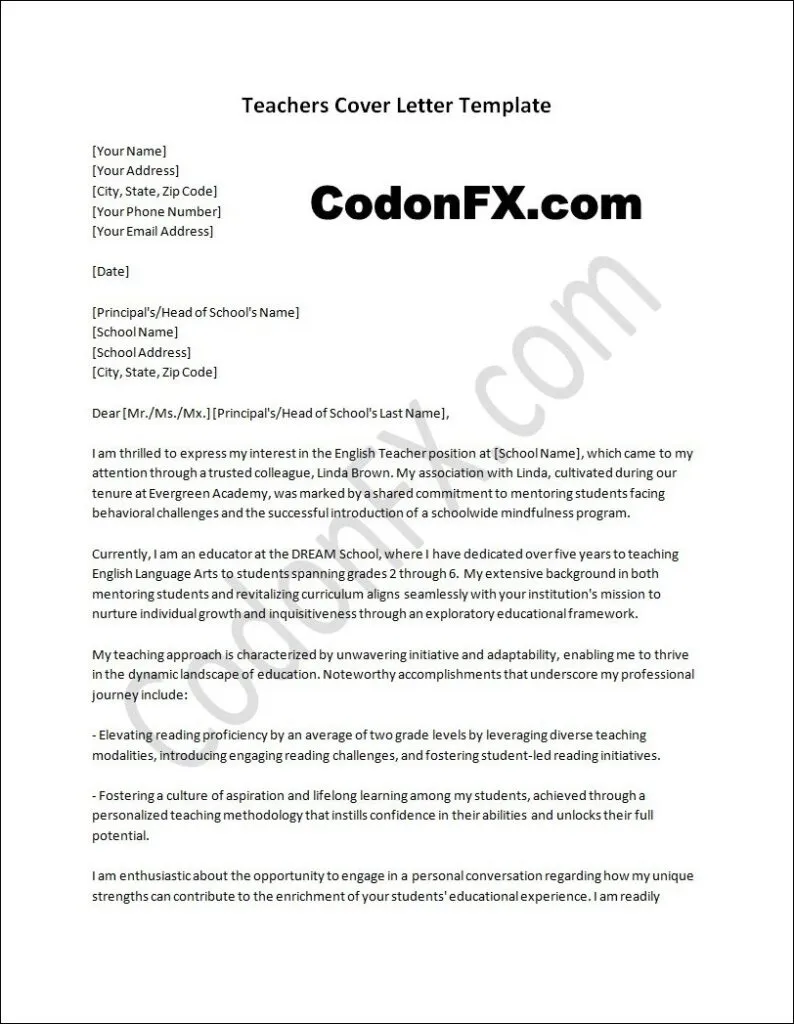
Expressing Enthusiasm
In your closing paragraph, reiterate your enthusiasm for the position and express your interest in an interview. Thank the reader for their time and consideration. You might also briefly summarize your key qualifications and reiterate why you are a strong fit for the role. Let them know that you are excited to discuss how you can contribute to their school community. This will give the employer the impression that you are passionate about the school and the job. (Image: enthusiastic-teacher.webp)
Providing Contact Information
Provide your contact information again in the closing, as a reminder and for ease of reference. State your phone number and email address so the hiring committee knows how to reach you. Make it easy for them to schedule an interview. Restating your contact information reinforces your availability and makes the hiring process more efficient. If you have a professional online portfolio or website, consider including a link in your closing as well. This can provide additional information and showcase your skills.
